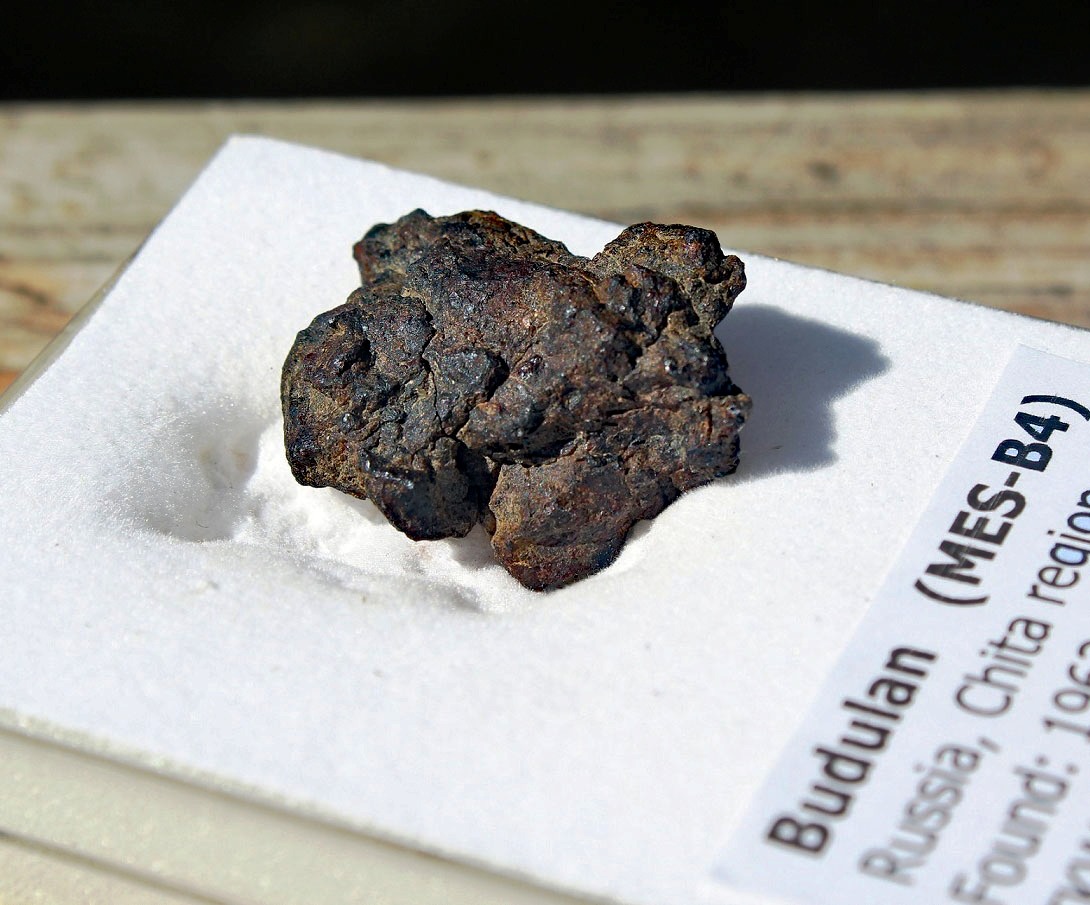|
Roll Overs:
1
2
3
|

|
12.1 gram end-cut. Mesosiderite-B4
TKW 100 kg. Fall not observed. Found 1962, Buryat National District, Chita Region, USSR.
   
John writes:
The snowy white, full metal, tops was one angle to highlight the also reflective veiny metal rich surrounding stratum.
From MinDat (see link above):
During a geological survey the meteorite was discovered almost completely buried in the soil by geologist N. N. Chaban and turned over to the Committee on Meteorites of the USSR Academy of Sciences. The silicate portion is predominantly orthopyroxene (70 vol%) with accessory plagioclase; the volumetrically comparable Fe-Ni Metal (~ 7% Ni) accounts for ~70% of the meteorite's mass. Like most mesosiderites, Budulan contains a diverse assortment of pyroxene and pyroxene-plagioclase clasts as well as a pyroxene-rich matrix. However, the silicate matrix has been shock melted even more extensively than the average brecciated assemblage. Within the assorted inclusions and clasts are some unusually magnesian-rich silicates, anorthite grains, and odd feldspars. Pentlandite (normally a weathering product when found in mesosiderite finds) occurs within symplectite aggregates of apparent preterrestrial origin.
Separate Ar-Ar dates of 3.82 Ga and 3.94 Ga suggests that Budulan material may have suffered one or more major collisions either while a part of an Original Parent Body (OPB) or on a major fragment of the OPD. Other mesosiderites and HED meteorites appear to have shared similar dramatic — even catastrophic impacts — during the same epochs. Oxygen isotopes also provide additional suggestive evidence for a possible shared history for the mesosiderites and the (mostly) Vesta-derived HED meteorites. Conclusive evidence for such shared histories, however, still seems somewhat elusive.
Budulan is the more massive of the two mesosiderites currently sub-classified as B4 mesosiderites (B=normal plagioclase abundance; petrologic type 4 = shock-melted matrix). As of 2000, most of the Budulan mass (98.4 kg) remained with the Academy of Sciences in Moscow with ~ 2 kg distributed in a few other places.
|
Click to view larger photos
#1
#2
#3
|
Found at the arrow (green or red) on the map below
|
|
| |
John lutzon
11/16/2023 2:20:13 PM |
Thank you Bernd; From C.A. Lorenz: In contrast to many other classes of meteorites, mesosiderites exhibit no traces of metasomatic processes. The Budulan mesosiderite is the first meteorite of this type in which traces metasomatism under the effect of an anhydrous fluid were detected. The metasomatic alterations are manifested as chemical zoning of olivine, aggregates of secondary minerals, and the mobilization and redeposition of iron and nickel in the form of metals and sulfides. Matthias, ha, i'm sure it took more than Open Sesame to reveal its glittering treasure inside. |
Bernd Pauli
11/16/2023 11:34:55 AM |
ALBRECHT A. et al. (2000) Light noble gases and cosmogenic radionuclides in Estherville, Budulan, and other mesosiderites: Implications for exposure histories and production rates (MAPS 35-5, 2000, pp. 975-986).
LORENZ C.A. et al. (2001) Silicate inclusions in a metal nodule of the Budulan mesosiderite: Mineralogy and origin (MAPS 36-9, 2001, A116). |
matthias
11/16/2023 5:18:42 AM |
Always Ali Baba's surprise: you first have something dark and, getting through, there's the overwhelming shimmering of the internal treasure site. Could be a stuff for psychoanalysts. And I must confess: never heard about Budulan. Chapeau, John. |
| |
|